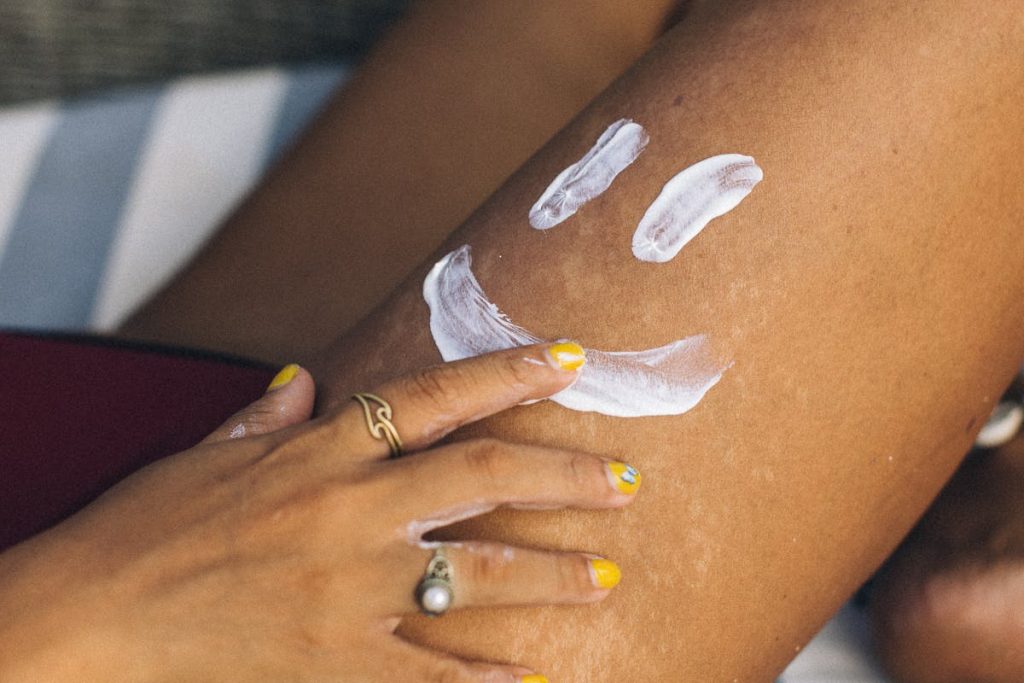
- Choose broad-spectrum sunscreen with a minimum SPF 30, apply generously to exposed skin, and reapply every two hours or after water exposure.
- Wear wide-brimmed hats, long-sleeved shirts, and sunglasses blocking UVA/UVB rays for additional sun protection beyond sunscreen application.
- You should perform regular self-examinations for new or changing skin moles or spots and undergo annual professional skin exams to detect early signs of skin cancer.
- Knowing the effects of UV radiation can help take appropriate preventative measures to protect skin from sun damage and long-term health issues.
Sunlight is a double-edged sword. On one hand, it’s our primary source of Vitamin D, which has significant health benefits, including bone health and immune system regulation. Excessive sun exposure poses serious risks to our skin health, ranging from premature aging to skin cancer. In this comprehensive guide, we’ll explore the complexities of sun exposure, focusing on its effects on skin health for health-conscious individuals, dermatology enthusiasts, and sun safety advocates.
The Science of Sun Exposure and Skin

The science behind sun exposure and its effects on skin health is fascinating and critical. When our skin is exposed to sunlight, it triggers a series of biological responses. These include synthesizing Vitamin D, essential for various bodily functions, and producing melanin, a natural sunscreen to protect our skin from harmful ultraviolet (UV) rays.
However, there’s a delicate balance to be struck. Too little sun exposure can lead to Vitamin D deficiency, while too much can cause DNA damage in skin cells, leading to premature aging and increasing the risk of skin cancer. In this section, we’ll dig deeper into the scientific mechanisms to arm readers with the knowledge needed to safely enjoy the sun’s benefits while minimizing its risks.
Understanding UV Radiation
Ultraviolet (UV) radiation, a component of the sun’s electromagnetic spectrum, illuminates the earth. It encompasses three distinct types of rays: UVA, UVB, and UVC. While the Earth’s ozone layer absorbs UVC rays and thus does not pose a risk, UVA and UVB penetrate the atmosphere and play a significant role in skin conditions. UVA rays are associated with skin aging, while UVB rays are linked to sunburn; both contribute to skin cancer risk.
Skin’s Response to Sunlight
Our skin reacts to sunlight in several ways. Immediately noticeable effects include tanning, which is often mistaken as a healthy glow when, in actuality, it is the skin’s defense mechanism against UV damage. In the long term, the consequences can be much graver, leading to photoaging, which is premature skin aging caused by repeated exposure to UV radiation.
The Role of Melanin
Melanin is the pigment that gives our skin, eyes, and hair their color, and it plays a crucial role in protecting our skin from sun damage. When skin is exposed to sunlight, melanocytes produce more melanin as a shield to absorb UV radiation. However, melanin’s effectiveness is limited, and overexposure to UV light can overwhelm our natural defenses, causing damage.
Health Risks of Excessive Sun Exposure

Excessive sun exposure, while often associated with immediate effects like sunburn, carries deeper health implications over time. The harm caused by prolonged UV radiation exposure goes beyond the surface, contributing to various skin conditions and increasing the risk of skin cancers.
Understanding these risks is essential for anyone looking to maintain healthy skin and prevent long-term damage. This section provides a comprehensive overview of the adverse effects of excessive sun exposure, highlighting the importance of sun safety in preserving skin health.
Sunburn and Its Effects
Sunburn is the immediate effect of too much UV light exposure, leading to red, painful, and sometimes swollen skin. Repeated sunburns, especially during childhood, can increase the risk of severe skin conditions in the future, including melanoma, the deadliest form of skin cancer.
Skin Cancer: Types, Causes, and Prevention
Skin cancer is the most common form of cancer globally, and excessive UV exposure is a significant risk factor. Melanoma, basal, and squamous cell carcinoma are closely linked to sun exposure. Fortunately, skin cancer is also one of the most preventable forms of cancer. Regular screenings, including self-examinations and dermatologist visits, are vital for early detection.
Premature Aging and Other Skin Conditions
Excessive sun exposure accelerates the breakdown of collagen and elastin fibers in the skin, leading to wrinkles, fine lines, and other signs of aging. Conditions like solar elastosis, the breakdown of skin due to sun damage, and actinic keratosis, a precancerous skin lesion, are also common.\
Consulting with a reputable dermatologist is critical in maintaining skin health, especially for those with high sun exposure or a history of skin issues. A dermatologist can provide expert advice on protecting your skin from sun damage, recommend sunscreens suited to your skin type, and devise a skincare routine that addresses any existing damage.
Regular check-ups allow for early detection of skin changes that might indicate skin cancer or other conditions. By leveraging a dermatologist’s specialized knowledge and skills, individuals can significantly reduce their risk of severe skin problems and ensure their skin remains healthy and vibrant.
Protecting Your Skin from Sun Damage
Sunscreen: Types, SPF, and Application Tips
Choosing the right sunscreen and using it effectively is crucial in protecting skin from UV radiation. Sun Protection Factor (SPF) indicates a sunscreen’s effectiveness in preventing UVB-induced sunburn. For daily use, dermatologists recommend using a broad-spectrum sunscreen with an SPF of at least 30, applying it generously to all exposed skin and reapplying every two hours or immediately after swimming or sweating.
Beyond Sunscreen: Additional Protective Measures
Other essential measures include:
- Wearing protective clothing, such as wide-brimmed hats and long-sleeved shirts.
- Seeking shade, especially during peak UV hours (10 a.m. to 4 p.m.).
- Wearing sunglasses that block UVA and UVB rays.
Routine Skin Examinations
Regular self-checks for new or changing moles or spots and annual professional examinations are crucial for catching potential skin cancers early when they’re most treatable.
Conclusion
Balancing sun exposure to harness its benefits while mitigating risks is essential for maintaining healthy skin. By understanding UV radiation’s effects, implementing protective measures, and conducting regular skin exams, we empower ourselves to enjoy the sun safely. Remember, protecting your skin today can prevent significant health issues down the line, making sun safety an investment in your long-term well-being.
